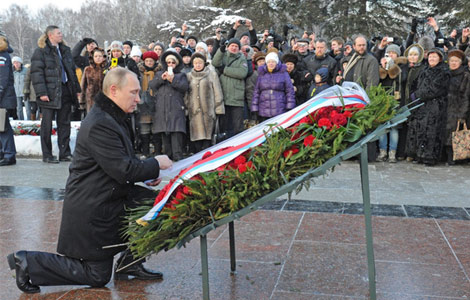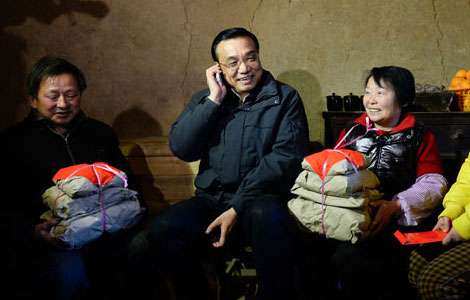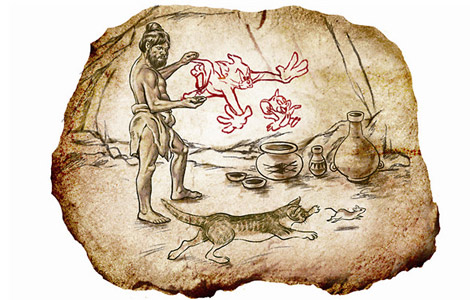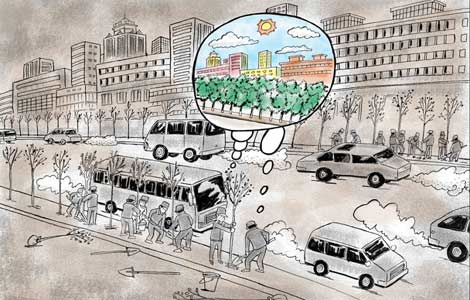Chinese firms introducing new forms of energy into Ethiopia
Updated: 2014-01-28 07:54
By Yao Jing (China Daily USA)
|
||||||||
Building on support from foreign aid projects, the companies are remaking the economic and infrastructure landscape in the African nation, reports Yao Jing
After a journey of 80 kilometers on the smooth Addis Ababa-Adama Toll Motorway, 34 white wind turbine towers came into view.
Arrayed along the Great Rift Valley, they were spinning in the wind. It was early December, the dry season in Ethiopia, and the undulating grasslands had turned yellow. In the far distance lay Addis Ababa.
The capital is just one part of Ethiopia where Chinese construction companies are changing the economic and infrastructure landscape of the African country.
The turbines, installed by HydroChina International Engineering Co Ltd, have supplied 200 million kilowatt-hours of electricity to households in Ethiopia in the past 20 months.
Not far away, the second phase of the Adama Wind Farm Project, which will have 102 wind turbine towers, has been launched.
"We expect to triple the installed capacity to 153 megawatts when (the second phase) opens in March," said Wang Yantao, deputy general manager of HydroChina International, a subsidiary of State-owned HydroChina Corp.
HydroChina is representative of the Chinese infrastructure enterprises that are building roads, bridges and housing in Ethiopia, catering to the country's construction boom.

They didn't stride into the promising but remote market alone; instead, they tapped into Ethiopia through Chinese government foreign aid projects.
"We launched the China-Aid Wind Power & Solar Energy Master Plan in 2011. The project took 17 months, and we designated 12 workers to operate the project," said Wang, who moved to Ethiopia at the beginning of the aid project.
As China's first technology-based foreign aid project in Ethiopia that involves renewable energy, Wang said the wind farm has become a catalyst for extracting the country's potential wind and solar power.
Wang's company has also gained much knowledge in the operation of the project.
The Adama One Wind Farm is the first wind power plant in East Africa. It has already been connected to the country's main power grid.
The project cost $117 million, with 85 percent covered by loans from the Export-Import Bank of China. The Ethiopian government provided the balance.
"All parts and machinery were imported from China. For the ongoing operations, we're employing 20 local workers and four Chinese staff," said Wang.
Challenges
He said his biggest challenge is developing a group of local employees, since many workers in Ethiopia are "complete strangers" to technology.
The second phase of the project has attracted investment of $245 million.
"It will take at least 20 years for us to recoup the investment," Wang said.
Ethiopia urgently needs infrastructure. It's banking on huge government-supported energy and transportation projects to help transform its agrarian economy.
Infrastructure projects required financing equivalent to 19 percent of Ethiopia's GDP in fiscal 2011-12 (the fiscal year starts on July 8), according to World Bank estimates.
"China's economic development model is a benchmark for Ethiopia. We hope to get more support from China, both in finance and technology," said Ahmed Shide, Ethiopian minister of finance and economic development.
Shide said that Chinese infrastructure projects have made "visible and significant" contributions to Ethiopia's road and rail facilities.
"At the same time, Ethiopia is providing market access to Chinese companies," said Shide.
As of Dec 31, 2012, the cumulative value of contracts signed by Chinese companies in Ethiopia totaled $18.82 billion, with $9.71 billion of work delivered.
Major sectors covered by these contracts include roads, power, telecommunications and water conservation, according to figures from the Ministry of Commerce.
China has completed 24 foreign aid projects in the country, such as the rehabilitation of the Aba Samuel Hydro Electric Power Plant and the construction of the Addis Ababa Municipal Road.
"Foreign aid is becoming a significant path for China's giant players to contribute to the development of Ethiopia.
"It's also pushing Chinese infrastructure builders into the 'going global' process," said Xie Xiaoyan, China's ambassador to Ethiopia.
Xie said that he attends at least one contract signing or groundbreaking ceremony each week.
Historic railway
Back in 1971, China financed and built the 2,000-km Tanzania-Zambia railway, the largest single foreign aid project undertaken by China at the time.
Decades later, the $124 million African Union headquarters in Addis Ababa, which was completed at the end of 2011 and handed over in 2012, was another major infrastructure project in China's foreign aid history.
As a latecomer to the marketplace, contractor China State Construction Energy Ltd is focusing on teaching local workers how to manage and maintain sophisticated projects.
"It is a good way to enter a new market, through the Chinese government's aid program. I think the Chinese government will emphasize different industries in different periods," said Liu Chunpeng, director for the technical cooperation group at the AU headquarters.
"Although we have missed the prime period for road construction, we are looking forward to the budding housing market," said Liu.
China Road and Bridge Corp, which entered Ethiopia relatively early in 1998, has built on its advantages with its core business of roads.
"Foreign aid projects contributed to prime the pump for our market growth," said Wei Qiangyu, deputy general manager of the company's Ethiopian office.
In the past 15 years, China Road and Bridge has built more than 2,000 km of roads.
Ethiopia-China Friendship Avenue, located in the center of the capital, was a project for the company in 2004. And China Road and Bridge is now working on the Bole Ring Road RBT Meskel Square Road Project, the first Ethiopian highway (the Addis Ababa-Adama Toll Motorway) and Addis Ababa Bole International Airport.
China Road and Bridge has big plans, such as developing commercial property or cooperating with local governments to establish integrated planning companies.
Wei said that whether a company can get a foothold in the market depends on whether its aid project can make a profit.
"I think the government should look at the capabilities of a company when it comes to bidding, not just considering the price," said Wei.
Contact the writer at yaojing@chinadaily.com.cn
(China Daily USA 01/28/2014 page13)

 Putin pays tribute to Siege of Leningrad victims
Putin pays tribute to Siege of Leningrad victims
 Chinese ace Li Na before she was famous
Chinese ace Li Na before she was famous
 Xi visits soldiers on frozen northern border
Xi visits soldiers on frozen northern border
 Premier calls for action to relieve poverty
Premier calls for action to relieve poverty
 Tough Guy event in England
Tough Guy event in England
 Syria talks bring offer of exit from siege of Homs
Syria talks bring offer of exit from siege of Homs
 Anti-World Cup protests wane in Sao Paulo
Anti-World Cup protests wane in Sao Paulo
 India celebrates 65th Republic Day
India celebrates 65th Republic Day
Most Viewed
Editor's Picks

|

|

|

|

|

|
Today's Top News
South China Sea archives open in Hainan
Some good US advice for Japan on comfort women
US, UK in app-tapping scandal
Border control for H7N9 tightens
Int'l hacker got caught in China
Party to reform discipline system
Talent returns to China, but progress slow
300 ill on Royal Caribbean ship
US Weekly

|

|







